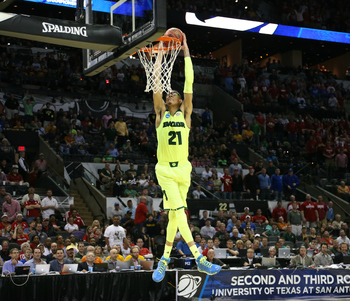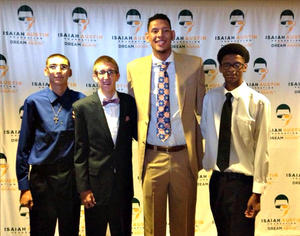 About a month before he was expected to become a first round pick in the NBA draft, Isaiah Austin found himself in the office of a heart specialist, getting a second opinion about a red flag that came up during a routine physical by league doctors.
About a month before he was expected to become a first round pick in the NBA draft, Isaiah Austin found himself in the office of a heart specialist, getting a second opinion about a red flag that came up during a routine physical by league doctors.
Dr. Robert Bonow sees a handful of these referrals every year, almost always false alarms. Bonow wasn't so sure this time. The 7'1" Austin indeed had many characteristics of Marfan syndrome, a condition that is potentially fatal and certainly career-ending.
The definitive answer would come from a blood test. Results wouldn't arrive until shortly before the draft.
Despite all of that hanging in the balance, Austin walked out of Bonow's office and pretty much forgot about it. He never even Googled the words Marfan syndrome.
"What are the odds of me really having it?" he told himself.
Elite athletes often develop an aura of invincibility; it helps them compete. They're also highly in tune with their bodies. Those were certainly factors in Austin's dismissive attitude. But there was more.
Years before, a freak injury stole the vision in his right eye. Austin powered on, fueled by his devout faith, becoming an All-American in high school and a star at Baylor University.
So whatever the future held, he'd be ready for it.
---
Marfan syndrome is a genetic disorder that infiltrates the connective tissue, the glue that holds a body together.
About 1 in 5,000 people have it. Patients are often tall, with fingers long enough to easily wrap around their opposite wrist. They also usually have stretch marks, sunken chests and/or vision problems.
Diagnosis usually begins with an accumulation of those characteristics.
Marfan syndrome becomes most dangerous when it invades the heart -- specifically, the aorta, the main blood vessel carrying blood to the rest of the body.
"The problem is that the aorta can enlarge to dangerous levels and can rupture or tear," said Bonow, Professor of Cardiology at Northwestern University Feinberg School of Medicine and a former president of the American Heart Association. "Increased stress on the aortic wall makes it more likely to enlarge or tear."
Now the good news: Marfan syndrome can be managed, especially when caught early.
---
Six days before the draft, Austin went through the NBA equivalent of a job interview with the Toronto Raptors, then flew home to Dallas.
He spent the next day working out and enjoying a barbecue at the home of NBA player Mo Williams.
Meanwhile, Austin's family and closest friends were gathering at his aunt's house.
While Austin was in Toronto, Bonow got the test result. He broke the news over the phone to Austin's mom, Lisa Green, who lives in Kansas. That night, she and her husband, Ben Green, drove to Dallas with Isaiah's younger siblings, Noah and Narah.
Along the way, Austin's mom called the people her son was going to need most. She asked Austin's high school coach to chaperone him to the fateful meeting.
Seeing all the cars outside his aunt's house was the first clue.
Walking in and seeing his mom's face "cherry red," her eyes swollen and tears on her cheeks was all he needed.
---
How would you react to such news?
To losing your career.
To losing a guaranteed multimillion-dollar contract.
To overcoming the loss of an eye only to be felled by a condition you've hardly heard of.
Austin went into a bathroom and let out some tears. About 10 minutes later, he emerged, ready to start a new chapter in his life, one in which he -- again -- refused to say, "Why me?"
He knew everyone would follow his lead. He was particularly concerned about his brother and sister.
So Austin sat on the stairs, smiled at Noah and Narah and said: "Everything is going to be OK. God has a different plan for us."
---
The plan began taking shape the next morning, with the way the sports world reacted to the news of this 20-year-old's career ending before it started.
NBA commissioner Adam Silver called to offer his regrets, and to invite Austin and his family to attend the draft anyway.
Midway through the first round, Silver introduced Austin and told his story. Then, the commissioner added, "to make sure he fulfilled at least this part of his dream ... it gives me great pleasure to say that with the next pick in the 2014 NBA draft, the NBA selects Isaiah Austin from Baylor University."
The attention Austin generated was a boon for awareness of Marfan syndrome.
One measure is the number of visitors to The Marfan Foundation website. Hits went from 65,129 in May 2014 to 468,811 in June, and that was with Austin's announcement coming on the 22nd of the month and the draft on the 27th.
A better measure is the story of Owen Gray.
---
When Owen was 6 and living in North Carolina, a doctor detected some characteristics of Marfan syndrome. Diagnostic tests were inconclusive. His parents were told to think about further testing as he grew older, especially once he hit puberty.
The family moved to the Houston area a few years later. Owen adopted Baylor as his favorite team, even attending its basketball camp the same summer that Austin arrived on campus.
As a long, lanky center himself, Owen loved watching Austin play. So the boy was devastated when he heard about Austin's diagnosis.
Owen's dad, Rod, considered it a wake-up call.
Reading about Austin, he realized his 13-year-old son had all the traits common to Marfan syndrome. Doctors soon confirmed it.
Soon after that, Owen adopted Austin's positive, inspirational attitude.
"For a few days after, I was sad that I couldn't play basketball anymore," Owen said. "But I knew I couldn't stay sad or mad about it. That would just make it worse. So I wanted to find a way to help other kids who were not handling it the way I was."
Owen also wanted to meet Austin. He figured he could by attending the inaugural event for the Isaiah Austin Foundation, a gala in October at the Dallas Mavericks' arena.
Tickets cost $500 each and Rod Gray was willing to scrape up the money for two tickets. But Owen really wanted $5,000 to sponsor an entire table, enabling other Marfan patients and their families to attend, too. His parents encouraged him to see how much he could raise.
 Owen generated $18,000 in donations, enough for three tables and recognition as a platinum-level sponsor. Only the Mavericks and the NBA joined him at that level. Owen also brought along two other children battling Marfan syndrome.
Owen generated $18,000 in donations, enough for three tables and recognition as a platinum-level sponsor. Only the Mavericks and the NBA joined him at that level. Owen also brought along two other children battling Marfan syndrome.
When Owen arrived, Austin said, "It's an honor to meet you!" launching a friendship that continues to deepen.
"He's pretty much become my big brother," Owen said. "Whenever I have a tough day, I text him and he'll reply right away. He's amazing."
Owen spoke in public for the first time a few weeks ago, buoyed by an encouraging text from Austin. Austin sent prayers last week, just before Owen underwent an MRI to determine whether he'll need heart surgery.
"Isaiah's friendship, encouragement and support of Owen has been unbelievable," Rod Gray said. "I credit him for saving my son's life. There's no telling how many lives he's affected."
---
Austin was 10 when a wild pitch in baseball found his right eye. In eighth grade, he went up for a dunk in pregame warm-ups and came down with blood gushing in the same eye.
His retina tore and had to be surgically repaired. After his fourth operation, Austin gave up.
"I just let my vision fade away," he said.
Marfan syndrome may or may not have been a factor. Regardless, he was a blossoming basketball star who had to learn how to play with one eye.
Austin spent countless hours in the gym "finding that muscle memory." He wore goggles and kept his condition secret, revealing it publicly only months before the NBA draft.
"I just wanted to show myself that I could do anything I put my mind to," he said. "It gave me a different strength, a different maturity than a lot of my peers had."
One he would rely on when facing the next major setback in his life.
---
Instead of breaking into the NBA, Austin has spent the last nine months becoming the face of Marfan syndrome.
There have been plenty of highlights.
The Boston Celtics declared him a "Celtic for Life" at their opener. Makers of the popular NBA 2K15 video game not only included him, "People tweet me all the time and tell me I'm a beast!" He took part in the NBA's All-Star weekend, serving as an assistant coach in the celebrity game and coaching a Special Olympics squad. He beams when talking about the players on the Special Olympics team, proudly adding that they erased a 20-point deficit on the way to victory.
His favorite part is meeting members of his new "Mar-family." He always offers encouragement and his phone number, vowing to take any call at any time. Owen's story is among the anecdotal evidence verifying he means it.
Austin also is back in school, working toward a degree in business. He could finish in December, maybe May. Whenever he's ready, a job with the NBA is waiting for him.
Of course, he continues leading his foundation and working with The Marfan Foundation, which has been leading the fight against Marfan syndrome and related disorders since 1981. In April, Austin will be honored with the organization's Hero with a Heart Award at its annual gala in New York.
(The Marfan Foundation and the American Heart Association have long, strong partnership, as our disease states are closely related. We are also aligned in our efforts to fund crucial research while also emphasizing awareness and programs to help patients and their loved ones.)
Austin also has remained connected to the Baylor basketball team as a manager, a role he cherishes even though his duties are more water boy than coach.
"It's a humbling experience," he said.
His health is good. Doctors say he can run and work out, and he occasionally plays pickup basketball games. The key is knowing his limits.
In June, Austin will release a book titled "Dream Again." That phrase has become his mantra since his pastor used it the day after his NBA dream was extinguished.
Austin's new dream is being a role model, not just to Marfan patients, but to people facing any type of adversity. He believes it's his calling, one with a longer, stronger reach than he'd have as an NBA player.
Still, he admits to occasionally bouts of wistfulness.
"I'll go to sleep at night crying because I miss playing basketball, I miss competing, I miss what people would call the lifestyle of being a rookie in the NBA," he said. "But at the end of the day I'm smiling because I know that I have a different purpose."
Isaiah Austin, Owen Gray (in Baylor jersey) and other Marfan syndrome patients at Boston Celtics' Marfan Night
Photo credits: action shot, Baylor University Photography; Owen and Marfan syndrome patients with Isaiah, Rod Gray; at Celtics game, Tim Joyce, The Marfan Foundation.

